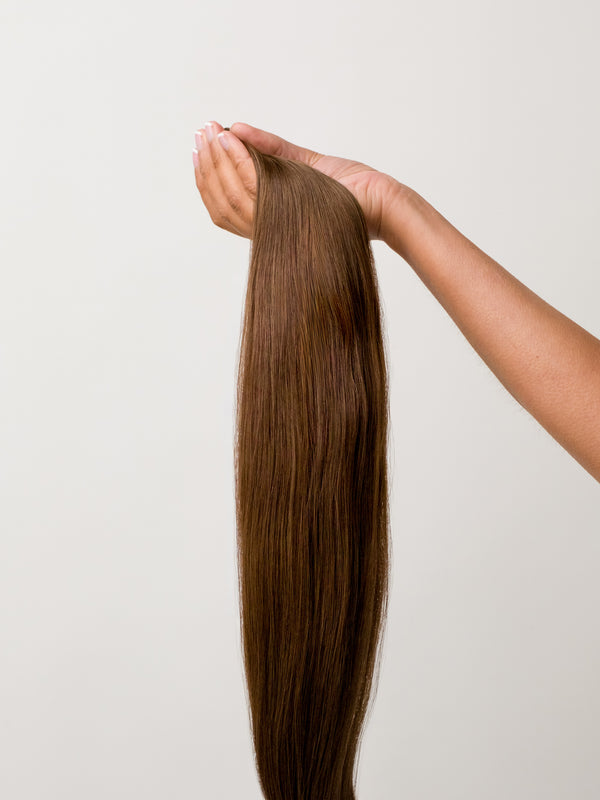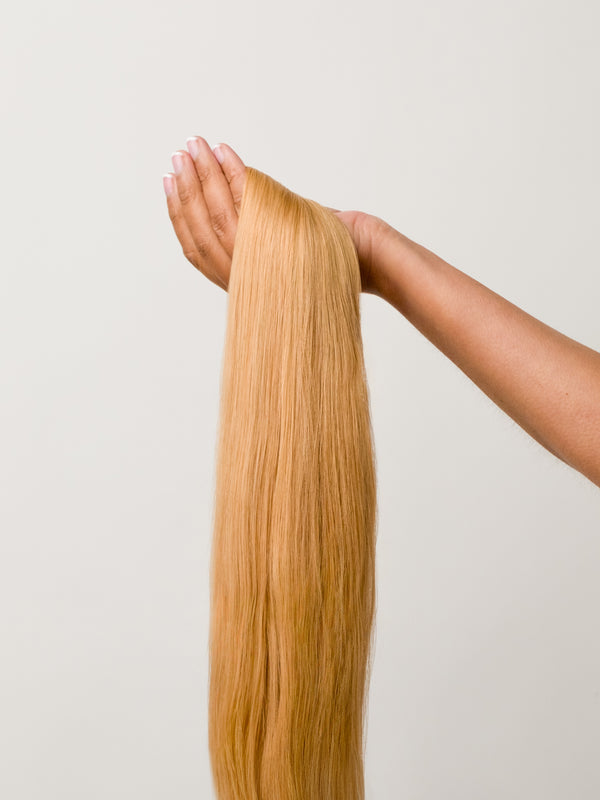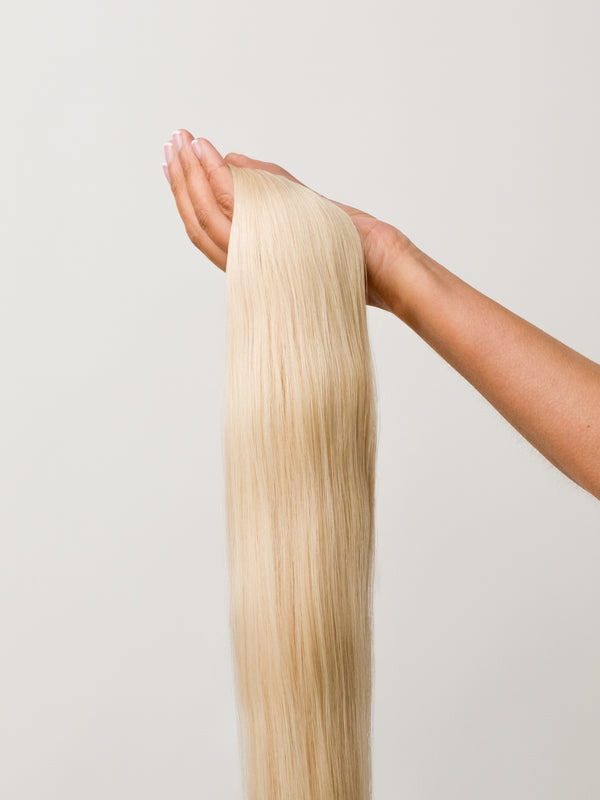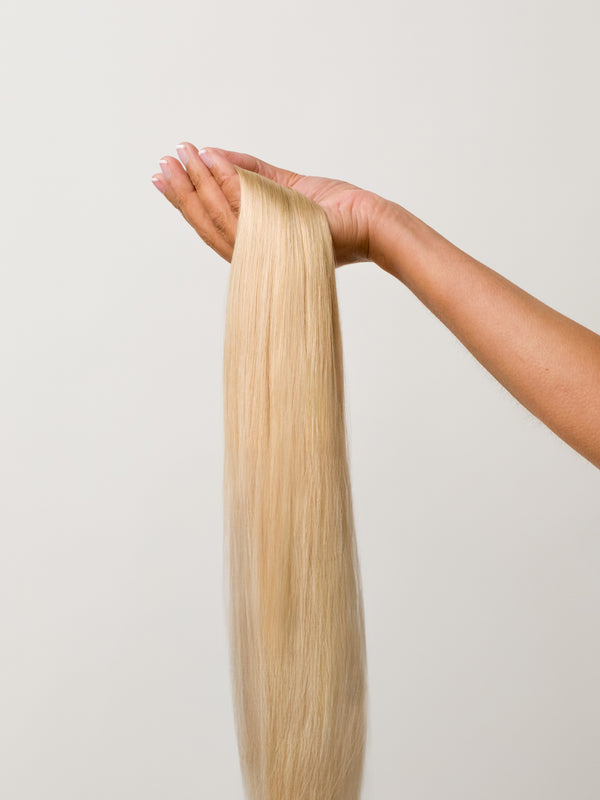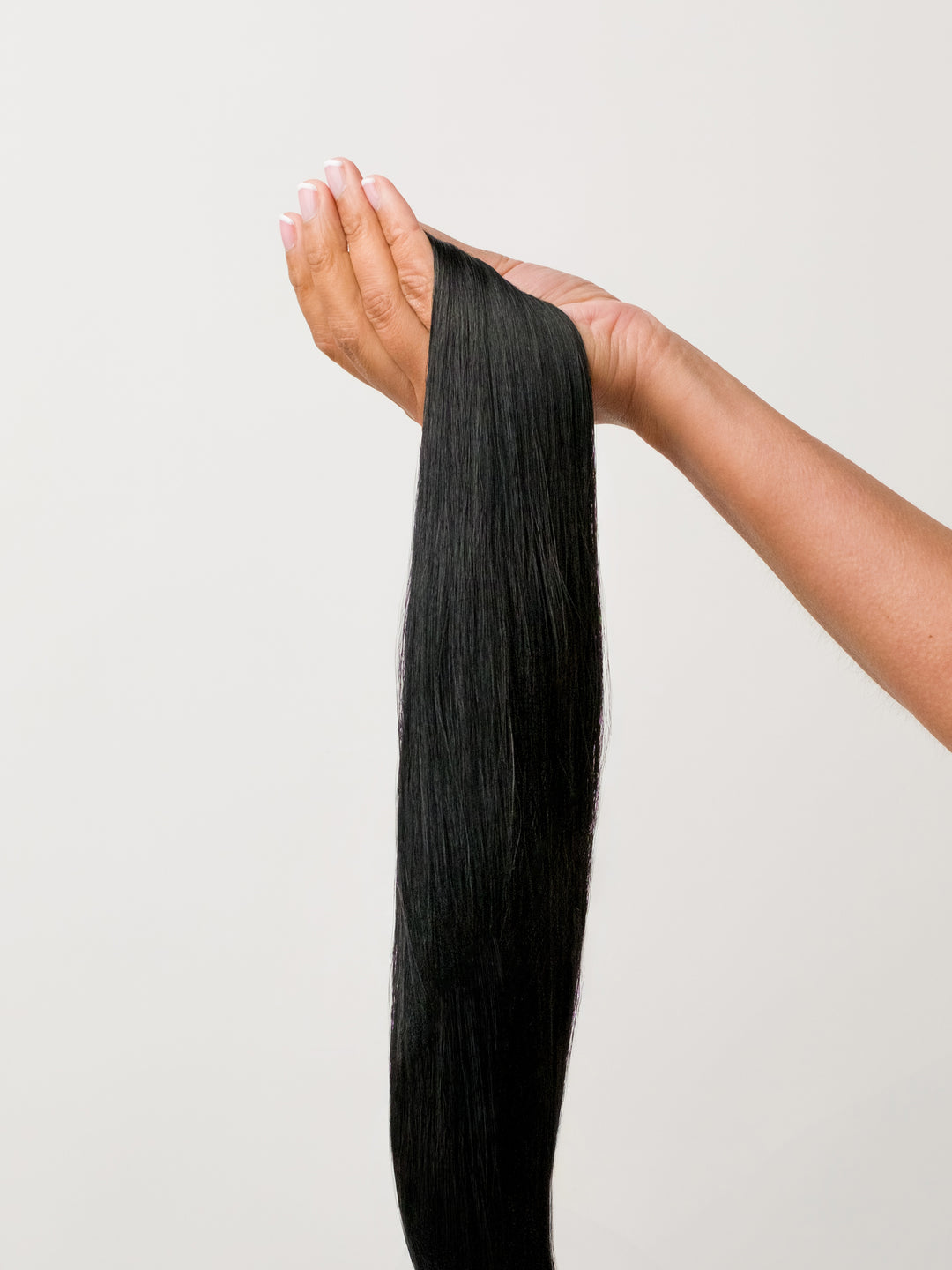Have you ever noticed your hair thinning or shedding more than usual? You're not alone. Around 50% of all women go through some noticeable hair loss at some point in their lives. If you're dealing with this issue, hair extensions can be a great solution.
You might be wondering, how much time does it actually take to get human hair extensions and maintain them?
The application process varies depending on the type of extensions. Clip-in extensions are the quickest option – it usually only takes around 15 minutes to put them in. But if you want something more permanent, like bonded or sewn-in extensions, you'll need to set aside 2-4 hours for the initial installation at the salon.
Just as crucial as the initial application, maintaining the hair is essential. Some extensions require minimal upkeep between salon visits, while others need more frequent trips and dedicated at-home hair care to prevent matting, tangling, or an obvious line of regrowth.
What You Will Learn
-
Different hair extension methods and how long each takes
-
Factors that affect application time
-
Maintenance needed to keep extensions looking good
-
Pros and cons of each extension method
-
Tips for choosing the right extensions for you
Real vs. Synthetic Hair Extensions
You've got two main choices here: real human hair or synthetic hair extensions.
If you go with real human hair extensions, you're getting the crème de la crème. These bad boys are made from actual strands of human hair, so they look and feel incredibly natural. They're also really versatile - you can use all the same products and styling tools on them as you would your own locks. The downside? They'll put a bigger dent in your wallet. But you get what you pay for with that longer-lasting quality.
Synthetic extensions are the budget-friendly option. Instead of human hair, they're made from artificial fibers. They can be a total gamechanger if you want to switch up your look without breaking the bank. Just beware that many synthetic versions can't withstand intense heat styling. You'll need to use approved products to keep them looking fresh.
Understanding Different Hair Extension Methods

Hair extensions come in a wide variety of forms and variations, but we'll concentrate on some of the most popular and inclusive groups.
Since each type has slightly distinct needs, it's critical to understand how they differ from one another.
Bonded Extensions
Your stylist has to use a special adhesive and heat tool to individually bond each extension strand to your natural hair. It's a meticulous process that can take 2-4 hours from start to finish depending on how much hair you're adding. They section off your hair, make sure it's protected, and meticulously attach anywhere from 50-250 individual strands.
Bonded extensions work best if you've got naturally thick, healthy hair. That way, you get a nice full head of hair that you can style however you want - sleek ponytails, bombshell curls, you name it. You can go with real human hair for the ultimate in quality, or save some cash with synthetic fiber extensions.
The bonding method is what makes these unique. Instead of wefts or rows, each strand gets individually keratin-bonded right onto your hair strand-by-strand. That keratin protein tip helps the extensions blend seamlessly while still moving naturally. You can even color and use hot tools on bonded extensions without worrying about damage.
Microlink Extensions
These extensions use tiny metal beads or cylinders to attach to your natural hair strand by strand. It's a delicate process that takes around 2-3 hours for a full head application.
Your stylist carefully sections your hair, threads the extension strands through, and then clamps those little metal beads shut to keep everything securely in place. No glue or heat needed, which helps prevent damage.
The best part about microlinks is how seamlessly they blend into your hair's natural texture and thickness- it's like you are not wearing hair extensions. Unlike tape hair extensions, you can style them however - curled, straight, updos, you name it.
With proper care like avoiding heavy oils around the beads, microlink extensions can last up to 6 months. But you will need to visit your stylist every few weeks for bead tightening and adjustments as your hair grows. Microlinks work for most hair types and allow lots of customization for length, color, you get the picture. The lack of adhesives is also gentler on your natural hair.
Clip-In Extensions
Clip in extensions come in strands with a clip at the top. The top layer of your natural hair conceals the slip, which you attach close to the roots of your hair. They may be used at home in a matter of minutes and are a stress-free technique suitable for all skill levels. Clip-in hair extensions require little upkeep and can last up to a year when worn frequently, longer if worn infrequently. Foxy Hair® extensions provide a natural look because they are made entirely of ethically sourced human hair.
Shop Roxy Hair
Tape Ins
Semi-permanent tape-in or bead-in extensions are usually applied by a licensed cosmetologist or hairdresser. Either a bead of glue or a piece of tape are used for this. Once your hair grows out, you'll also require expert assistance to remove these. You can reuse your hair extensions with new glue if you have clean ones and have maintained them well.
Sew Ins or Braided Extensions
Thicker hair is intended for use with sew-in hair extensions. These can be quite heavy and uncomfortable, and applying them usually takes several hours. On the other hand, these also feel the safest and last the longest.
Factors Affecting Hair Extension Application Time
The time it takes to get hair extensions installed in your own hair can vary quite a bit depending on several factors.
-
The type of extensions themselves plays a big role - individual keratin-bonded strands like fusion extensions and even indian hair typically require more time compared to tape-in or clip-in wefts.
-
The style you want is also key. If you're looking for something intricate involving braiding or adding highlights and color, you can expect a lengthier appointment. Simpler styles are generally quicker to do.
-
Your own natural hair texture makes a difference is another factor to consider. Finer, more fragile hair needs extra care during application to prevent damage, which adds time. Thicker, coarser hair provides a hardier base for the hair extensions.
-
Most importantly, your stylist's experience level significantly impacts the timeframe. An expert hairstylist who has done thousands of extensions can work much more efficiently in just a few hours than someone newer to the techniques.
Hair Extension Maintenance

Hair extensions give an instant beautiful look. But keeping them good-looking requires home care whether you have a long, fine or thin hair. Proper care from the start is the key.
-
Wash Extensions Properly
Use the shampoo and conditioner recommended by your stylist for your specific extension type. Avoid products with sulfate and alcohol to prevent stripping natural oils and matting. Use cold water to flow down your hair when washing to minimize tangling. Shampoo the roots and condition the hair ends only.
-
Never Sleep with Wet Hair
When the hair is wet, it is more fragile and delicate. It is advisable to always fully dry your hair before bed. Wet hair gets tangled easily when you move around at night while sleeping. The wetness makes the hair strands weaker and knottier. We suggest invest in a good hairdryer.
-
Brush Gently
Don't just use any brush. Get a good brush made for extensions. Start brushing at the bottom ends first. Then work your way up to the roots. Brushing from the ends up prevents pulling and breaking the extensions. Be gentle when you brush. Do it in the morning before you start your day. Also brush before bedtime. And don't forget to brush before and after you wash your hair.
-
Deep Condition Weekly
Hair extensions don't get the natural oils from your scalp like your normal hair does. So you need to deep condition the extensions once a week. This helps them stay healthy and grow properly. Use nourishing oils like argan or coconut oil. Or use deep conditioning hair masks with natural ingredients. But be careful - don't put the conditioner too close to the roots where the extensions are attached. That can make them slip out. Focus the deep conditioner just on the middle and ends of the extensions.
-
Minimize Heat Damage
Before you use a flat iron or any hot tool on your hair, spray on a heat protectant product first. This creates a barrier so the high heat doesn't damage your hair as much. Also, try not to use the highest heat settings on hot tools like flat irons. Keep the temperature on low or medium instead of maximum high heat. And give your hair a break from all that heat styling when you can. Try heatless styles like overnight curls or updos.
-
Avoid Night Tangling
Gather your hair loosely into a low ponytail or braid before going to sleep. Don't make it too tight. Keeping your hair collected like this while you sleep stops it from getting tangled up and knotty from tossing and turning on the pillow. But use soft, gentle hair ties that won't pull or damage your hair. Avoid tight elastics that can break strands.
-
Separate Bonds Daily
Use your fingers gently each day to untangle any knots or tangles around the little bonds where your extensions are attached. Doing this quick, careful separating with your fingers stops the bonds from getting too matted up and tangled together. If you leave those little knots, they can turn into big tangled messes around the bonds over time.
-
Maintenance Appointments
It's important to visit your hairstylist on a regular basis for your hair extensions maintenance. How often you need to go depends on the type of extensions you have. At these appointments, your stylist will reposition any extensions that have shifted out of place. They'll also trim off any scraggly ends to neaten up the extensions. And they can check over all the extension hair to make sure everything still looks fresh and neat.
Pros and Cons of Different Hair Extension Methods

Just a few strands and how many extensions can make a world of difference for your hair. Whether how hair extensions applied carefully, maintaining and caring for them. Although there has been significant advancement in extension installation or attachment methods techniques in recent decades, not all approaches are created equal.
Wigs
Pros: Wigs are a great way to get a totally new hairstyle without actually having to do anything to your own hair. They're great for those with thin or fragile hair that can't handle hair extensions.
Cons: You'll need to remove your wig before bed to prevent matting or friction on your natural hair overnight.
Tape-In Hair Extensions
Pros: Tape-in extensions give you a seamless, undetectable look, especially for straight to wavy, thick hair. They're considered lower damage since no chemicals are used during installation.
Cons: You'll have to avoid oily or silicone-based products that could cause the tape hair strands to slip. Premature removal risks major shedding and damage.
Clip-In Extensions
Pros: Clip-ins let you add instant length and volume at home without any salon visit needed. They're easy for beginners to install themselves and adapts well to your natural hair color.
Cons: The weight of clip-ins may be too much for thin or fragile hair types over time.
Sew-In Extensions
Pros: Sew-ins or hand tied hair extensions are ideal for curly and coarse textures wanting long-lasting extensions. When done by a skilled stylist, sew-ins cause minimal damage without any heat or adhesive used. They can be worn for an extended period.
Cons: You must stay on top of caring for your natural hair underneath to prevent buildup and issues. Improperly tight braids can lead to hairloss.
Micro Link Extensions
Pros: Micro links give you flexible, natural-moving extensions secured to small sections of hair. This technique is gentle for those with thin or fine hair. The extensions blend seamlessly into your own hair.
Cons: Over time, the micro links have the potential to slip and become visible, especially on shorter hair lengths.
Pre-Bonded Fusion Extensions
Pros: Fusion extensions use a keratin bond so they move and style 100% like natural hair. They're excellent for thick, coarse hair wanting a long-lasting, seamless installation. No wefts or rings are required.
Cons: The heat and keratin adhesives used can potentially cause damage if not applied carefully. Only trust an experienced, certified stylist for installation and removal.
Summary
In the end, understanding the different extension techniques, factors affecting application time, essential maintenance routines, and the pros and cons of each option is crucial for keeping your extensions looking their best.
We've explored wigs, tape-ins, sew-ins, micro-links, and more. With this knowledge, you can make an informed choice on the right extensions for you.
If you're considering clip-in extensions for an instant style upgrade you can do yourself, check out our quality options. Our clip-ins are easy to use, look amazing, and let you switch up your hairstyle whenever you want without a salon visit. Give your hair some treat today!
Frequently Asked Questions
How long does it take to sew in extensions?
It can take anywhere from 3 to 6 hours to sew in extensions, depending on different factors like the type and length of hair, as well as whether you have assistance or not.
How long does a full head of hair extensions take?
It usually takes around three hours to fit a full head of individual strand hair extensions, but this time can vary based on the method used.
How often do I need maintenance appointments for my hair extensions?
You should visit your stylist every 5 to 10 weeks to maintain your hair extensions and keep them in top condition.
Can I apply clip-in hair extensions by myself?
Yes, you can easily apply clip-in hair extensions by yourself at home, taking about 5 to 15 minutes for a full head.






